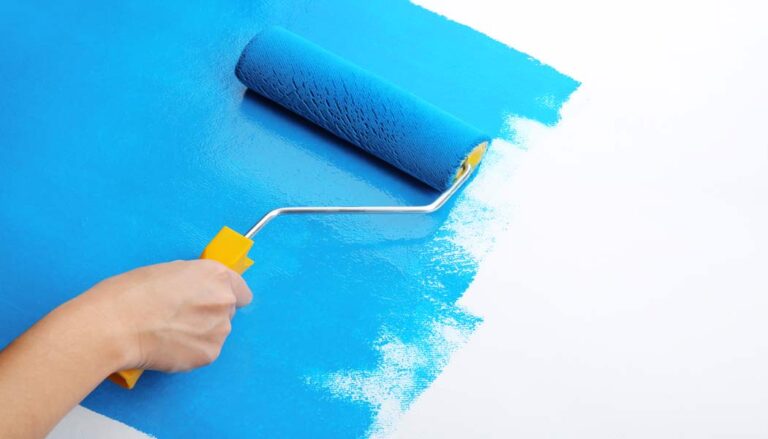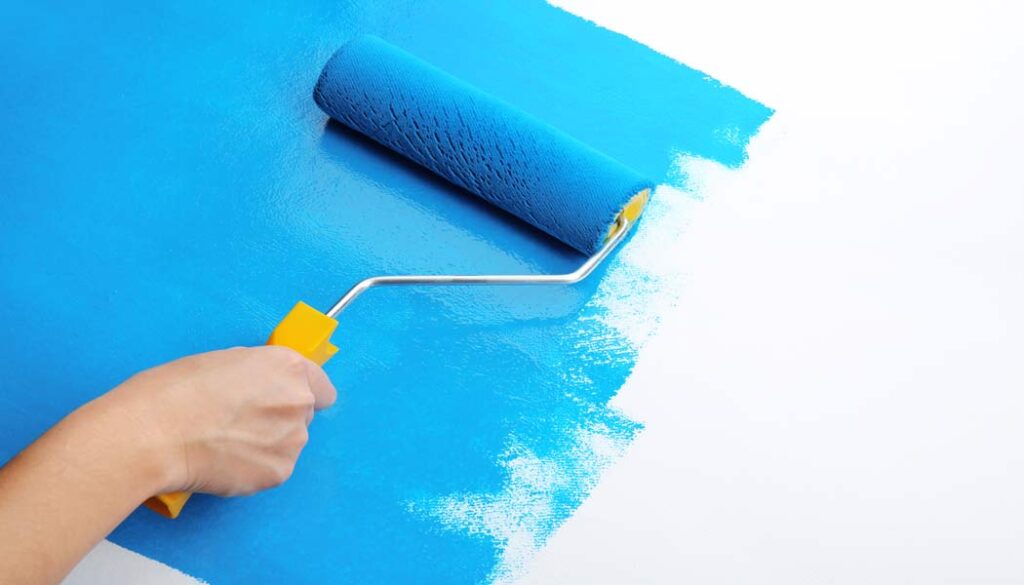
Can You Roll Dry Fall Paint?
If you are thinking of painting your high ceiling or interior walls and want to apply dry fall paint, it’s normal to ask a simple question before getting started – can you roll dry fall paint?

To answer the question, we would say yes, you can. But we would also suggest you not do it at first. You can give it a try by spraying first, then use rollers if you wish.
This article will answer different questions about this paint, plus walk you through how to use dry fall paint, step by step. So, buckle up, and keep reading.
What Is Dry Fall Paint Used For?
Before we go any further, let’s talk about what dry fall paint is.
Dry fall paint is a special type of industrial product or paint that is designed for spray application. By the way, it is also well-known as drop-dry paint.
This paint comes with some additives that help the paint dry fast. That’s why this versatile paint overspray dries very fast and thus reduces the damage due to overspray. And not only that but since it dries fast, the excess paint remaining on the surface can simply be swept away which makes it a great choice for industrial and commercial usage.
In commercial and industrial settings, this paint is most commonly used because these places require a professional touch. Apart from that, this paint can also be applied in residential settings. So, you may opt for this special paint for painting your ceilings, stores, basement walls, warehouse, garage floors, etc.
Plus, dry fall coatings come in different formulations like alkyd, epoxy, acrylic, etc. You can use it on a wide range of surfaces; like steel, wood, aluminum, gypsum, etc. So, if you think that your chosen surface is a bit uncommon to paint, don’t worry!
But you need to pick the right type of coating depending on the surface material, the environment, and the final look. And you can use this paint on an existing surface or a new one if you wish to do so.
Is Dryfall Paint Water Based?
Yes, dryfall paint can be water-based.It can come in a wide range of formulations like alkyd, epoxy, acrylic, and more. So, it’s no wonder that you will find water-based dry-fall paint. In fact, you can find many water-based interior dry fall paints in the market.
Can You Roll Dry Fall Paint?
You can, but we would suggest you not do it at first. As we said earlier, this paint is specially designed for spray application, so you can try spraying first.
It’s very common to overspray during paint application. It’s even more common for beginners. But that’s where you get to see the advantage of dry-fall paint.
Since dry fall paint comes with some additives that help the coat dry fast, you don’t need to worry about damage due to over-spraying. You can simply sweep away the excess paint. So, it’s less messy and less hassle.
However, we don’t want to limit your creative hands to simply spraying the paint. You may try painting with a traditional roller. And it would be a smart choice if you are thinking of covering a large area without making the surface too runny and messy. If you want to paint high walls, you can take an extension pole.
This will assist you reach further areas and achieve better coverage. You should try to make each stroke as even as possible, focus on making strokes with the same amount of paint you took for the previous stroke.
However, we think you already know that in some cases the pros of spraying outweigh the pros of rolling. So, it’s clear that spraying can cover areas where it’s harder to reach with a roller.
And you will be able to cover better with sprays than a traditional roller. That’s why we say, it’s okay to roll dryfall paint, but you should give it a try by spraying first.
Learn How to Rolling Walls (DIY) Like a Pro:
Can You Brush Dryfall Paint?
Since dry fall paint is specially designed to be sprayed on, it’s better to stick with paint sprayers to apply it. Spray paint will give you way more advantages than traditional rolling and brushing applications.
However, similar to what we said earlier, we don’t want to confine the application method to spraying only. You are encouraged to try different ways as well. So, you may give it a try with brushes and see how it goes.
Can You Use Dry fall Paint on Walls?
Yes, you can use dryfall paint on walls. Because it comes in different formulations, it works well on a wide variety of surfaces. That’s why you can use this paint on a variety of surfaces, but you may find it applied mostly on ceilings.
However, apart from ceilings, you can use this paint on warehouses, walls of condominiums, garage floors, and so on. So, we say yes, dry fall paint is applicable on walls.
How to Apply the Dry Fall Paint?
Dry fall paint is most commonly used on ceilings; we are going to discuss how you can spray this paint on the ceiling. Using the same procedures for applying on the ceiling, you can apply on other surfaces as well.
It may be necessary to make slight adjustments to the procedures depending on the surface and the location. So, let’s take a look at the step-by-step procedure.
Step 1: Lay Plastic Drop Cloth
While using dry fall paint, paint drippings may not be a thing of concern, but the excess paint will turn into powder, so it’s better to cover the furniture, floor, and other nearby objects with a plastic drop cloth. As a result, your furniture will not become dusty, and it will make the cleaning process easier once you are done painting.
Step 2: Remove the Dust from the Surface
Before we start painting, we need to make sure the surface is clean. There can be dust, dirt, grime, oil, etc. on the surface which can act as a barrier between the surface and the paint and thus reduce the durability of adhesion.
It’s better to use a pressure washer to clean the surface. A pressure washer allows you to clean spots that are hard to reach manually. However, a pressure washer may not be available every time.
That’s why an alternative would be to use a grinder to sand the surface well and brush off all the dust and debris manually. Sanding will help better paint adhesion.
Step 3: Repairing the Surface
If the surface you are intending to paint has some cracks, dents, or splits, you should repair the surface first. This is more applicable if you are doing a restoration project.
Step 4: Priming
If the surface you are planning to paint is a wooden surface, you should not proceed without a primer. Apply a high-quality primer before you move ahead. If the surface you are going to paint is made of iron, some spots on the surface may require priming. So, make sure to apply a good primer.
Step 5: Applying the Paint
Spray the paint from the paint sprayer, maintaining a proper distance. Try to make the coats as even as possible. Keep moving the sprayer nozzle as you cover the areas, and don’t hold the sprayer in the same spot for too long. Thus, you will be able to reduce dripping and achieve a better finish.
If you need to apply multiple coats, wait for the previous coat to dry before applying a new one. If it needs retouches on some spots, do it very carefully so that the retouches blend in with the surrounding paints.
Step 6: Cleaning
After you are satisfied with the paint, you can clean the powdered overspray and remove the drop cloth. If you wish to use a coat using a roller, you may go ahead, but make sure the previous coat is properly dried. In this case, you should do the cleanup after rolling.
See How to Paint using dry fall paint:
Painting Galvanized Metal with Dry Fall Paint
If you are thinking of painting galvanized metal with dry fall paint, there is a disclaimer. When it comes to painting a galvanized metal surface, you should be a bit more careful. You should avoid using alkyd dryfall on this surface.
If you apply alkyd paint, a chemical effect will take place is which called “saponification” or “zinc soap”. This reaction will result in detaching the paint from the exterior. All your hard work will be wasted, and you will need to start over.
To overcome this problem, you can apply 100% acrylic paint instead of using alkyd type paint. Another useful option to solve this issue would be to use a two-component epoxy solution.
Final Thoughts
When over-spraying causes issues, dry fall paint is the ideal solution. This paint overspray dries very fast and thus reduces the damage due to overspray. The excess paint remaining on the surface can simply be swept away, making your work easier and less messy. In this article, we talked about applying dryfall paint using different instruments. So, if you wish to apply the paint the traditional way instead of spraying, remember the answers we gave in the article.
